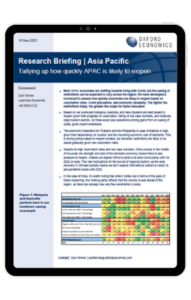Research Briefing
APAC | Tallying up how quickly APAC is likely to reopen

Most APAC economies are shifting towards living with Covid, but the easing of restrictions can be expected to vary across the region. We have developed a scorecard to assess how quickly economies are likely to reopen based on vaccination rates, Covid prevalence, and economic necessity. The tighter the restrictions today, the greater the scope for faster relaxation.
What you will learn from this report:
- Based on our scorecard Malaysia, Australia, and New Zealand are best placed to reopen given their progress on vaccination, falling or low case numbers, and relatively large tourism sectors. All three would also experience strong gains from an easing of curbs, given recent lockdowns.
- The economic imperative for Thailand and the Philippines to ease limitations is high, given their dependency on tourism and the mounting economic cost of restraints. This is driving policymakers to reopen borders, but domestic restrictions are likely to be eased gradually given low vaccination rates.
- Despite its high vaccination rates and low case numbers, China scores in the middle of the pack; the strength and size of the domestic economy means there is less pressure to reopen. Indeed, we expect China to stick to its zero-Covid policy until H2 2022 at least. This has implications for the revival of regional tourism, as the slow recovery in Chinese tourists means we don’t expect international visitors to return to pre-pandemic levels until 2025.
- In the case of India, it’s worth noting that while it ranks low in terms of the pace of future reopening, the ranking partly reflects that the country is well ahead of the region, as there are already now very few constraints in place.
Tags:
Related Services

Post
US Key Themes 2026: Exceptionalism amid fragmentation
US exceptionalism is alive and well, and that won't change in 2026.
Find Out More
Post
Global Key themes 2026: Bullish on US despite AI bubble fears
We anticipate another year of broadly steady and unexceptional global GDP growth, but with some more interesting stories running below the surface.
Find Out More[autopilot_shortcode]
